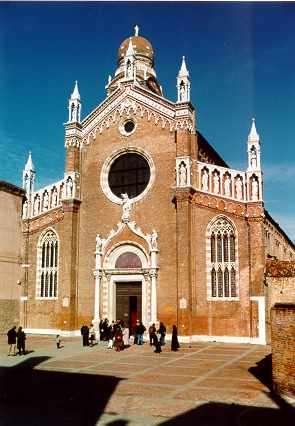|
Venice > Sightseeing > Madonna dell'Orto
Madonna dell'Orto

ABOVE: Madonna dell'Orto has
been described as "the finest Gothic church in Venice."
By
Durant Imboden
Madonna
dell'Orto is a church and a parish that most Venice tourists never see. In
Venice: A Literary Companion, Ian Littlewood explains what they're missing:
Venice follows the usual law law of tourist
cities: the least frequented areas are among the most agreeable. The heart of Cannaregio,
into which we are about to step, is still a somewhat isolated region with its own
unmistakable atmosphere. As one moves farther north, towards the Madonna dell'Orto, the
canals and fondamente grow wider. There is more space, more light, and yet a sense of
diminished prosperity. The rhythms of life are slower and more communal than in the swirl
of the city centre.
Tintoretto's Church [the Madonna dell'Orto]
has a noble brick façade and a graceful interior....but it is probably the church's
paintings that draw most visitors out to this northern reach of the city--as they have
done for over a hundred years.
The paintings are by Tintoretto, who lived and worked just a few blocks
away on the Fondamenta dei Mori. Hugh Honour, art historian and author of The Companion Guide to Venice, describes Tintoretto's connection to the church:
This was Tintoretto's parish church--he is buried with his family
in the chapel to the right of the high altar--and it is rich in his works. On either side
of the high altar there are vast paintings of The Worship of the Golden Calf and The
Last Judgment, each about fifty feet high. Tintoretto, his fingers itching to fill
the empty spaces on these chancel walls, is said to have asked no recompense other than
the cost of the materials."
John Ruskin, the 19th Century art critic and social commentator, painted
this evocative verbal portrait of The Last Judgment:
...the river of the wrath of God, roaring down into the gulf where
the world has melted with its fervent heat, choked with the ruin of nations, and the limbs
of its corpses tossed out of its whirling, like water-wheels. Bat-like, out of the holes
and caverns and shadows of the earth, the bones gather, and the clay heaps heave, rattling
and adhering into half-kneaded anatomies, that crawl, and startle, and struggle up among
the putrid weeds, with clay clinging to their clotted hair, and their heavy eyes sealed by
the earth-darkness."
Other notable features of the church (besides a plethora of fine
paintings) include Tintoretto's tomb (see above) and a statue of a "Madonna of the
Garden" (Madonno dell'Orto) in the chapel of San Mauro, which was discovered
in a neighboring garden in the late 1300s and was said to possess miraculous powers. The
statue served as an excuse to renovate the church, which originally was dedicated to St.
Christopher and has been used as a gunpowder magazine, a barn for storing straw, and a
stable at various times in its nearly 650 years of existence.
Transportation, hours, and surroundings
See the next two pages for
information on how to reach Madonna dell'Orto, when the church is open, and things to see
in the vicinity (with photos).
Next page:
Visitor information
About the author:
 Durant Imboden has
written about Venice, Italy since 1996.
He covered Venice and European travel at About.com for 4-1/2 years before launching
Europe for Visitors (including
Venice for Visitors) with Cheryl
Imboden in 2001. Durant Imboden has
written about Venice, Italy since 1996.
He covered Venice and European travel at About.com for 4-1/2 years before launching
Europe for Visitors (including
Venice for Visitors) with Cheryl
Imboden in 2001.
PC Magazine has called this "the premier visitors'
site for Venice, Italy." Over the years, it has helped more than 30 million
travelers. For more information, see About our site,
our Europe for Visitors
press clippings,
and
our reader testimonials.
| 
